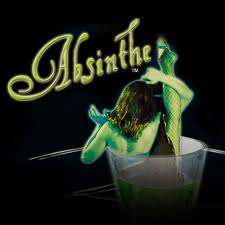The Drinking Absinthe Frappe
Back in the fall, I expressed some interest in the learning to make cocktails, and my sister even bought me a cocktail shaker and measure for Christmas. I made a few Bloody Marys using the last of a bottle of vodka that my friend Yuri gave me years ago, but soon forgot about my newfound hobby. That is, until last week, when the New York Times ran a summer cocktail story. I flipped to the inside pages, which featured colorful pictures of mouth-watering summer cocktails, including something called the Absinthe Frappe.
The Absinthe Frappe appealed to me because I happen to have a bottle of absinthe, which I bought in 2008, shortly after the long-banned liquor became available in the U.S. The drink’s notoriety stemmed from the mistaken belief that it caused hallucinations; these hallucinations were believed to be caused by thujone, a chemical found in the herb wormwood. But a New Orleans-based chemist named Ted Breaux proved that absinthe’s thujone content was tiny — less than 10 parts per million. And since the US had never banned absinthe outright — the law simply prohibited food and beverages containing more than 10 parts per million of thujone — Breaux was able to bring a brand of absinthe called Lucid to market.
Traditionally, drinking absinthe is a multi-step process that utilizes special equipment: a slotted absinthe spoon. Typically, drinkers pour 1.25 to 1.5 ounces of the liquor into a glass, then place a sugar cube on top of the slotted spoon, which rests on the rim of the glass. They then slowly drip 4 to 5 ounces of cold water onto the sugar cube, which dissolves into the absinthe. The cold water releases the oils in the mixture and brings out the flavors, causing a milky cloud, known as the louche, to form.
This multi-step process is a lot of fun, but I never came to truly love absinthe, which might explain why the bottle of Lucid has gathered dust on my kitchen counter. However, the Absinthe Frappe recipe in the Times revived my interest in the liquor, partly because it sounded unusual — an absinthe frappe? — and partly because it only required 3 ingredients: heavy cream, lime juice and simple syrup. I wasn’t sure exactly what simple syrup was, but a friend assured me that it was easy to make — “They call it simple syrup for a reason,” she said — and that all I needed to was combine equal amounts sugar and water. In any case, here’s the recipe:
1 1/2 ounces absinthe
1 ounce heavy cream
3/4 ounce lime juice
3/4 ounce simple syrup
Pour the ingredients into a cocktail shaker, add cracked ice and shake hard for 20 seconds. Pour it all into a highball glass and serve with a straw.
Anyway, I did all this and, sure enough, the result was a frothy, frappe-like drink. I loved the texture, but I wasn’t sure about the taste: absinthe is quite strong, and I wondered if maybe I should have put in more simple sugar, or more cream, to soften the liquor’s harsh edges. I made the Absinthe Frappe a couple nights ago, adjusting the ingredients, but I still didn’t like the drink all that much. Which was unfortunate, because I loved the idea of it. Of course, maybe I just loved the idea of an alcoholic frappe, which I could make at home and drink on a hot summer night. In any case, my interest in cocktail making has been revived, and I plan to try out more summer cocktail recipes.
Absinthe is historically described as a distilled, highly alcoholic (45–74% ABV / 90-148 proof) beverage. It is an anise-flavoured spirit derived from herbs, including the flowers and leaves of the herb Artemisia absinthium, commonly referred to as "grande wormwood", together with green anise and sweet fennel. Absinthe traditionally has a natural green colour but can also be colourless. It is commonly referred to in historical literature as "la fée verte" (the "green fairy" in French).
Although it is sometimes mistakenly called a liqueur, absinthe is not bottled with added sugar and is therefore classified as a spirit. Absinthe has a very high level of alcohol by volume but is normally diluted with water when consumed.
Absinthe originated in the canton of Neuchâtel in Switzerland. It achieved great popularity as an alcoholic drink in late 19th- and early 20th-century France, particularly among Parisian artists and writers. Owing in part to its association with bohemian culture, consumption of absinthe was opposed by social conservatives and prohibitionists. Charles Baudelaire, Paul Verlaine, Arthur Rimbaud, Henri de Toulouse-Lautrec, Amedeo Modigliani, Vincent van Gogh, Oscar Wilde, Aleister Crowley and Alfred Jarry were all known drinkers of absinthe.
Absinthe has been portrayed as a dangerously addictive psychoactive drug. The chemical thujone, present in small quantities, was blamed for its alleged harmful effects. By 1915, absinthe had been banned in the US and in most European countries including France, The Netherlands, Belgium, Switzerland and the Austro-Hungarian Empire. Although absinthe was vilified, it has not been shown that it is any more dangerous than ordinary spirits. Its psychoactive properties, apart from those of alcohol, have been much exaggerated.
A revival of absinthe began in the 1990s, when countries in the European Union began to reauthorize its manufacture and sale. As of February 2008, nearly 200 brands of absinthe were being produced in a dozen countries, most notably in France, Switzerland, Spain, and the Czech Republic.

No comments:
Post a Comment